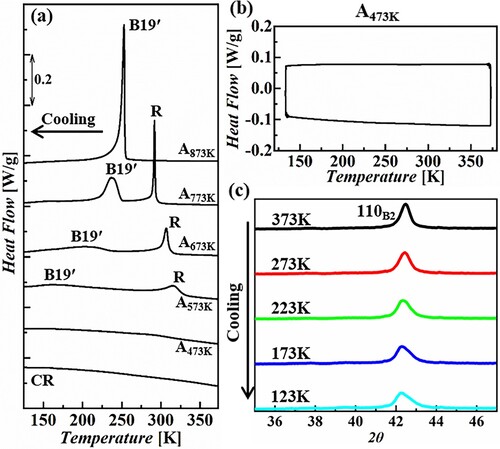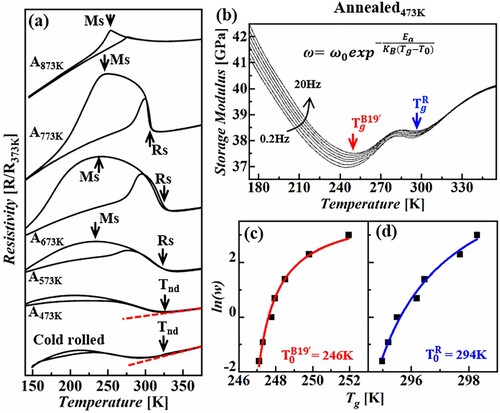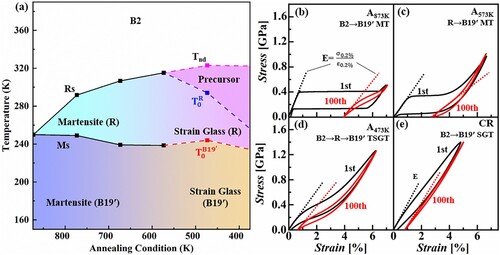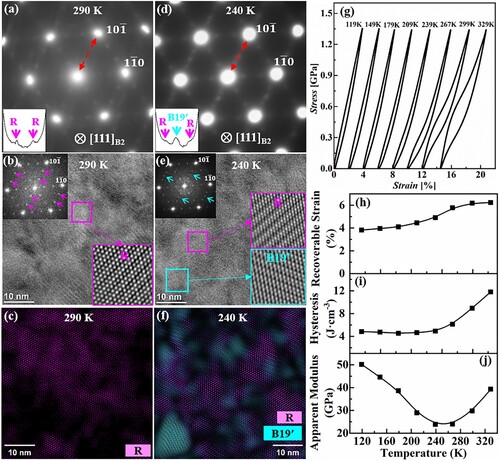Figures & data
Figure 1. DSC and in-situ cooling XRD analysis. (a) DSC heat flow curves upon cooling of the CR and A473K∼A873K samples. (b) Cooling and heating heat flow loop of the A473K sample. (c) In-situ cooling XRD profiles of the A473K sample.

Figure 2. Resistivity and DMA measurements of the A473K sample. (a) Resistivity measurements. Tnd refer to onset temperatures the R-like precursor. (b) DMA analysis of the 473 K annealed sample. (c–d) Fitting of the Vogel–Fulcher relation for two frequency-dependent dips.

Figure 3. Phase diagram involving various transition pathways and corresponding tunable superelastic properties.

Figure 4. Comparisons of the superelasticity under different transition pathways with various superelastic materials. (a–c) The strength, recoverable strain, and Young’s modulus under different transition pathways. (d) Comparison of the recoverable strain and Young’s modulus with various superelastic materials, including the NiTi-based SMA [Citation38,Citation39], NiTi-Nb composite [Citation40], Cu69Al17Mn14 single crystal [Citation41], Cu-based SMA [Citation42,Citation43], Mg-based SMA [Citation44], Ti-based SMA [Citation45,Citation46], Fe-based SMA [Citation47], TiNiFe composite [Citation24], and Co25Ni25(HfTiZr)50 high-entropy alloy [Citation48].
![Figure 4. Comparisons of the superelasticity under different transition pathways with various superelastic materials. (a–c) The strength, recoverable strain, and Young’s modulus under different transition pathways. (d) Comparison of the recoverable strain and Young’s modulus with various superelastic materials, including the NiTi-based SMA [Citation38,Citation39], NiTi-Nb composite [Citation40], Cu69Al17Mn14 single crystal [Citation41], Cu-based SMA [Citation42,Citation43], Mg-based SMA [Citation44], Ti-based SMA [Citation45,Citation46], Fe-based SMA [Citation47], TiNiFe composite [Citation24], and Co25Ni25(HfTiZr)50 high-entropy alloy [Citation48].](/cms/asset/ced1d486-1e22-4bc0-9670-51fa8b592c98/tmrl_a_2373285_f0004_oc.jpg)
Figure 5. TEM observation upon cooling and the associated wide-temperature superelasticity of TSGT. (a, d) TEM-SAD patterns at 290 and 240 K. The intensity profiles of the insets are plotted along the red dashed line. (b, e) HR-TEM images at 290 and 240 K. (c, f) IFFT images corresponding to HR-TEM observations. (g) Wide-temperature superelasticity measurements. (h–j) Recoverable strain, hysteresis, and Young’s modulus in relation to testing temperature.


